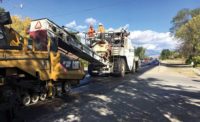ENR Mountain States 2017 Best Projects
IM Highway/Bridge Best Project: Provo Westside Connector

Provo’s Westside Connector, also called the Lakeside Parkway, improves access to Provo Municipal Airport and the southwest part of town.
PHOTO COURTESY OF HORROCKS ENGINEERS

Provo’s Westside Connector, also called the Lakeside Parkway, improves access to Provo Municipal Airport and the southwest part of town.
PHOTO COURTESY OF HORROCKS ENGINEERS


Provo Westside Connector
Provo, Utah
Best Project
Owner: UDOT
Client: Provo City
Lead Design Firm: H.W. Lochner
General Contractor: Ames Construction
Civil/Structural Engineer: Horrocks Engineers
Geotechnical Engineer: IGES
Right-of-Way: HDR Engineering
Construction Inspection: Stanley Consultants
Provo’s Westside Connector, also called the Lakeside Parkway, improves access to Provo Municipal Airport and the southwest part of town. Local officials expect tremendous growth in the area over the next 25 years, and the new road will be a catalyst for that. The connector also opens the west side of the valley to further residential and commercial expansion.
For example, the airport could be reached only via Center Street, a main business and residential roadway. Now, the connector offers direct access to the airport from Interstate 15. Provo High School is planned for relocation to the west side of the city, and additional retail and residential development is expected to follow, creating jobs and improving the local economy.
Economic growth often involves trade-offs with the environment. The Westside Connector was one of 14 infrastructure projects nationwide expedited for environmental review and permitting by the Obama administration in 2011.
Environmental concerns included preserving the wetlands through which the new road was being built. Working with the U.S. Army Corps of Engineers, the project team created or enhanced 30 acres of wetlands and took care to optimize water retention. The work included building a nesting platform for raptors.
Local livestock farmers also were critical stakeholders. The project literally cut some of their operations in half. As a result, crews built access roads and gates into the affected properties.
During the project, all construction operations were regularly shut down as crews helped farmers load their cattle into trailers and move them back and forth across the site.
Constructing a major road through a wetland area brought engineering challenges as well. To lower groundwater pressure, crews installed more than 1,000 perforated wick drains in a 53,000-linear-ft area, then added 4 to 8 ft of overburden to push the soil down and drain the water.
In eight months, crews recorded more than 3 ft of settlement. Construction proceeded after piezometer readings confirmed that the soil settlement had leveled out, with no more than an inch expected in the future.
Related Article: Institutional Work Leads Field of 2017 Best Projects Winners


-04_ENRready.jpg?height=200&t=1668199635&width=200)


